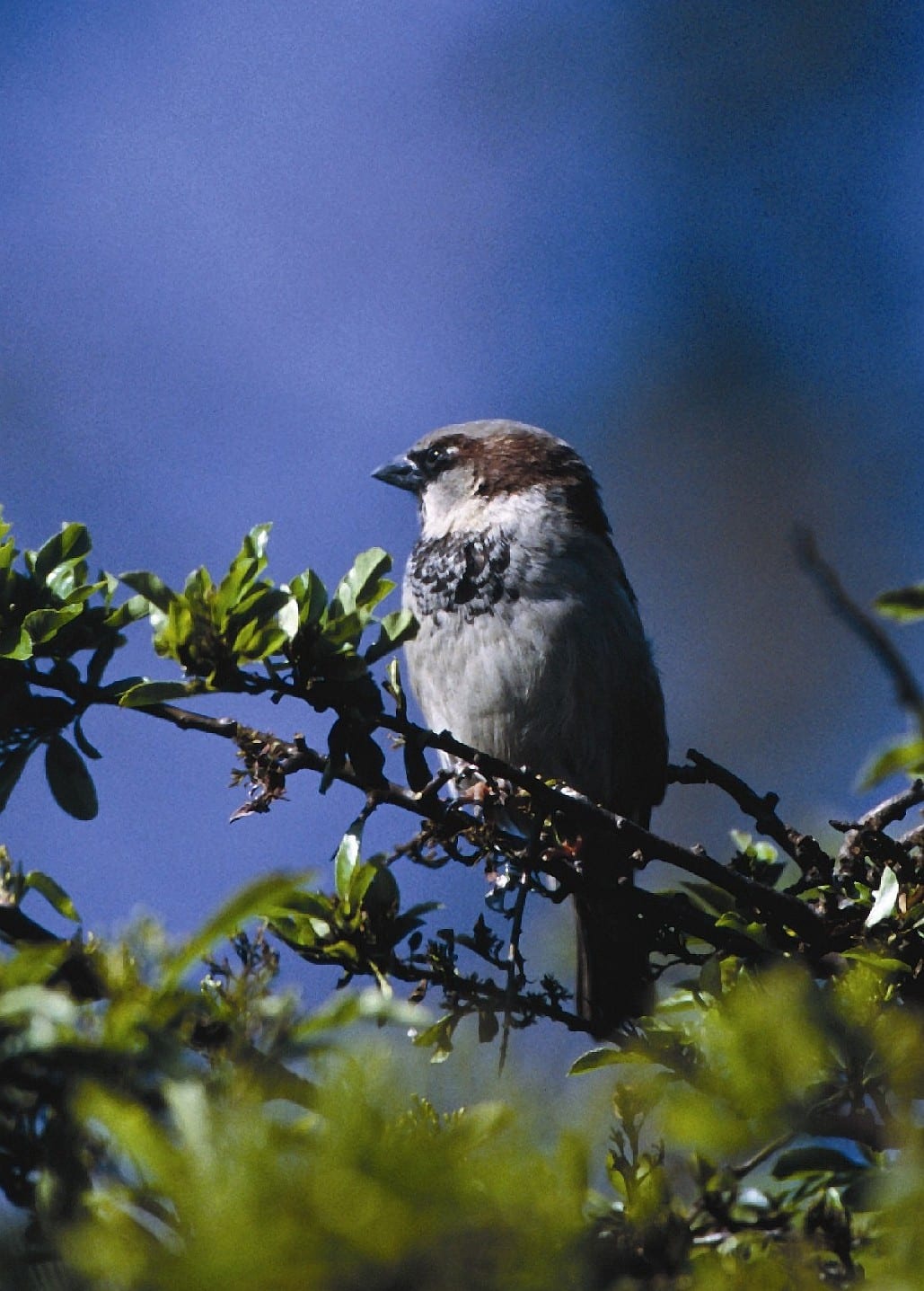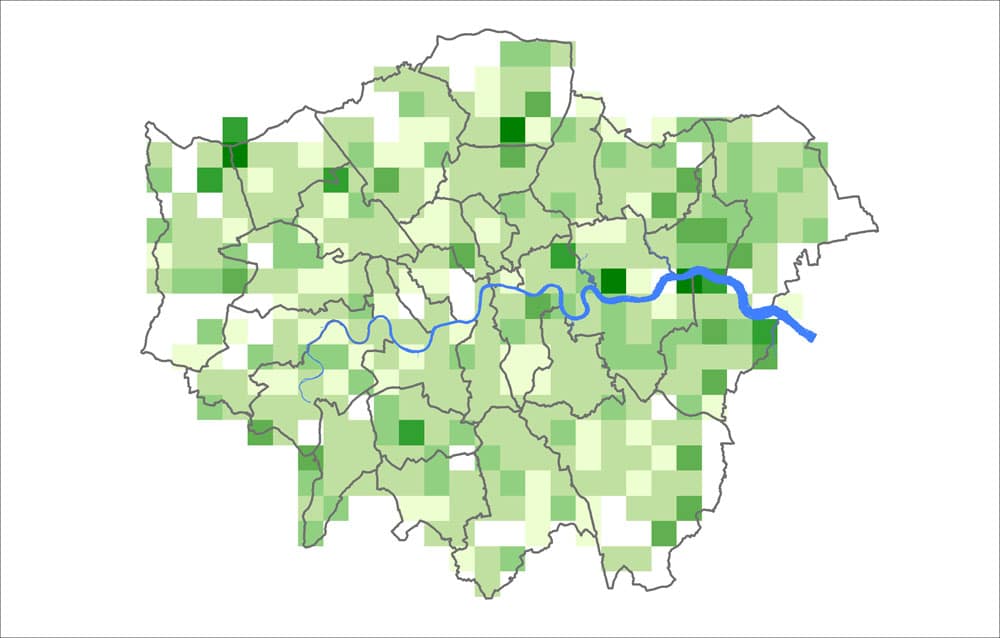Eleanor Reast, RSPB
Why study the ubiquitous Cockney sparrow?

In areas as large and complex as London, it is increasingly important to work with partners to share knowledge and expertise.
Did you count your sparrows this year?
Back in 2002, the RSPB and London Biodiversity Partnership launched a public survey, “Where have all the sparrows gone?”. It asked residents if they had house sparrows in their gardens or local area. The survey was hugely popular and the findings gave the RSPB valuable information about where sparrows were still to be found, as well as highlighting the plight of this once prolific bird. The results found population numbers were greater on the outskirts of the city, with numbers gradually diminishing towards the centre and absent from its heart.
Ten years on, the RSPB, together with London Wildlife Trust, GiGL and other members of the London Biodiversity Partnership, ran the Cockney Sparrow Count; a repeat of the original citizen science survey. The aim was to update the distribution map, inform further house sparrow research and continue to raise awareness of the plight of house sparrows in London. It also provided participants with positive actions they can undertake for wildlife.
GiGL, with their wealth of experience in this area, created and hosted the Cockney Sparrow Count survey form. To give continuity and allow fair comparisons, the 2012 survey asked the same questions as those posed in 2002.
The results are in

The RSPB received regular updates from GiGL over the four week survey period. GiGL then had the mammoth task of analysing the data and trying to make sense of what it was showing! Preliminary findings show little change over the decade but on average there appear to be more birds per sighting in the east than in the west of London. The average count of sparrows per sighting was slightly higher this year at eight, compared with six in 2002.
Direct comparison is not possible because of the many variables inherent in citizen science but general trends have been revealed. The findings align with anecdotal and scientific studies. More analysis of the results is planned by the RSPB’s conservation science staff.
The findings dramatically improved the baseline data GiGL holds for this once common and widespread bird. We’d like to thank everyone who submitted their results and urge people to continue submitting sightings of house sparrows using GiGL’s online survey form.
The Cockney Sparrow Count once more opened Londoners’ eyes to their natural surroundings. The survey’s popularity in the capital can be attributed to the close working partnership between GiGL, London Wildlife Trust and supporters of the London Biodiversity Partnership.
The RSPB will be sending all participants packs of specially selected wildflower seeds to sow, building on their empathy for this small bird to encourage positive action in their gardens and outdoor spaces benefiting house sparrows and other urban wildlife.

I’m on the outskirts, has 2 pairs nesting g in myvrood & another nesting in my bay tree, they seem to have had 2 baby’s each so have a nice group now. One pair replenishing their nest again wow.
Thanks Jo, that’s great to hear. We’d love to include your sightings in our species dataset. Please can you provide further details on our submit records form here: https://www.gigl.org.uk/submit-a-record/.
I have not seen sparrows in my garden for years and yet now all of a sudden today I have seen at least 3 and it looked like one was going into the ivy building a nest. Why this has occurred now is lovely and amazing to see.
I live on the outskirts of Mitcham in the borough of Merton.
How lovely Simon that you’re seeing sparrows in your garden again. We’d love you to submit a formal record so it can be used for conservation management decisions: https://www.gigl.org.uk/submit-a-record/. Fingers crossed you have some young birds to report soon too!
I came to this site, because to my surprise I saw three sparrows in my garden on two occasions last week.
Back in 2015/2016 I was out of work and staring out of the same window for months on end, saw many birds but no sparrows, and I haven’t seen a sparrow in Kingston in the 13 years I have lived here.
Could lockdown have brought them back?
Hi Adrian,
That’s great you’re seeing sparrows in your garden. Whilst it’s too early to know for sure, lots of anecdotal evidence suggests the lockdown could be effecting London’s wildlife. Would you be able to submit a formal sighting through our website here, https://www.gigl.org.uk/submit-a-record/, so we can add the record to our database? It’ll then get used in conservation decisions.
Thanks,
Julie
Hi
I’m the same . I live in sw15 Roehampton. There is a giant bay tree next door and there are many sparrows flying about . Or is there another look alike bird? Anyway I noticed a magpie enter the tree today and he was buzzed by many little birds. As many as 10 or so involved . All looked like sparrows to me . Would little birds of different types club together in this scenario? Of course there could be many nests in there as it is height of double storey house.
I would support view bird life in my garden has taken off as planes were grounded. Quite dramatic change for the better. I assume they moved in from countryside or in my guess richmond park and Putney heath ..
I have several pairs of nesting sparrows in my garden. I see on average 10 sparrows a day and so far there have been 3 separate hatchings in a hole under my roof. Most days they are insect catching perched on my trees and plants. Welcome sight
I have been putting seeds out regularly since May 2020; I started because birds visiting my garden had become rare over the last decade. I got some “I love robins” feeders to encourage sparrows back into my garden (we have pigeons who would just eat all the seeds, if they had access). Every day there are easily 2 dozen sparrows feeding on the seeds I have put out.
It was nice last year, in the midst of the doom of lockdown, to hear the bird song with little or no traffic noise. I guess I should say that I live right on the edge of the city of London in East London with a very small garden that is surrounded by a nondescript hedge.
I have no idea how much impact my tiny effort will have on the bird population. But I would encourage others to consider doing something similar because urban wildlife does need preserving and collectively we could make a difference.